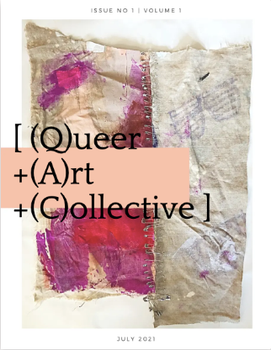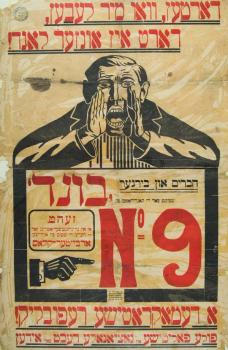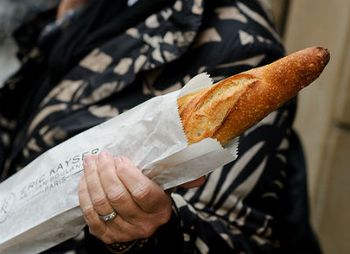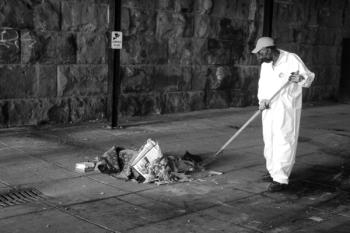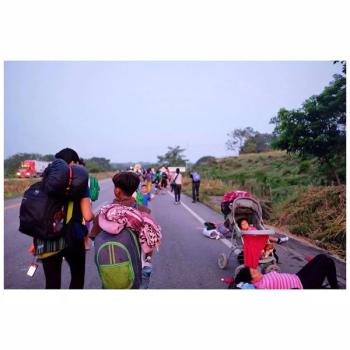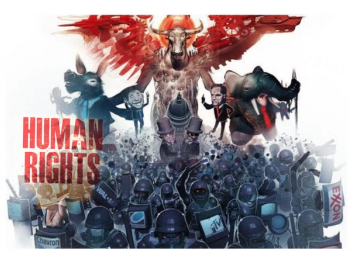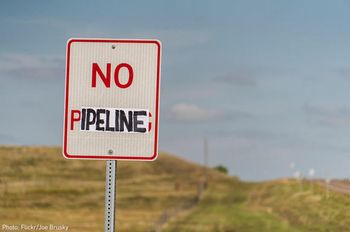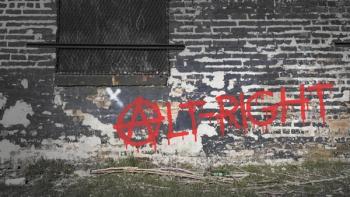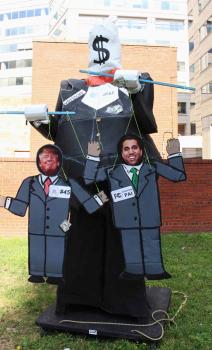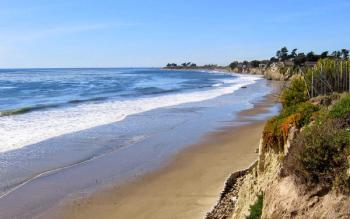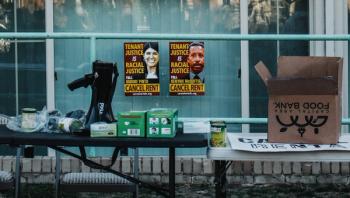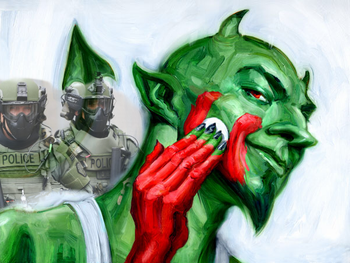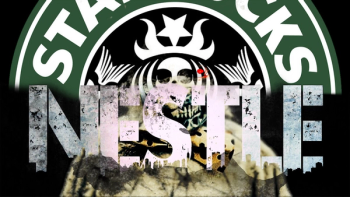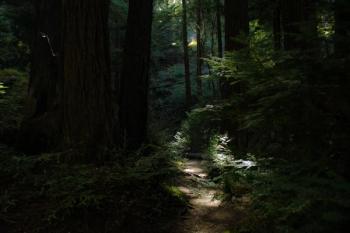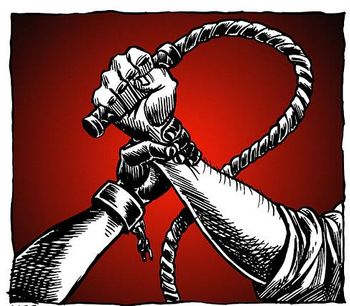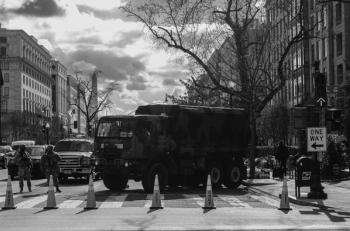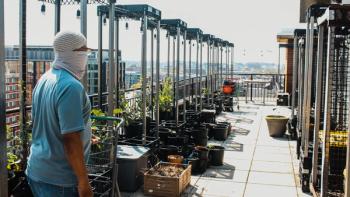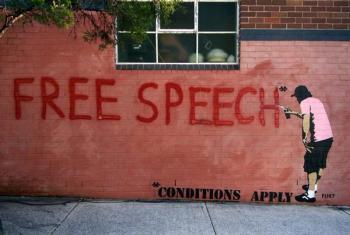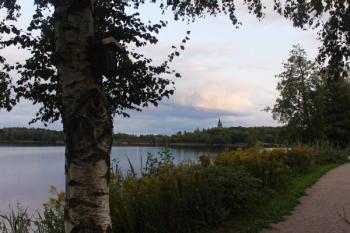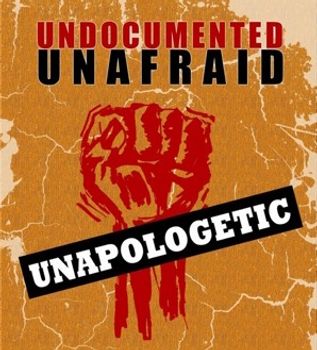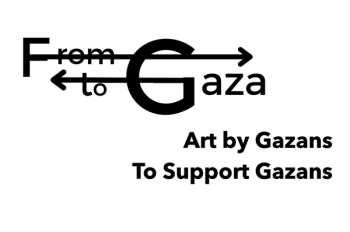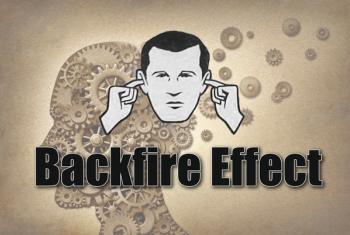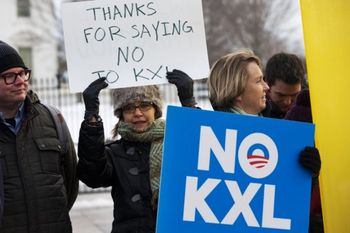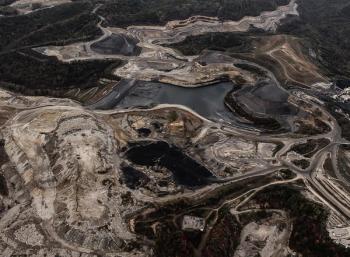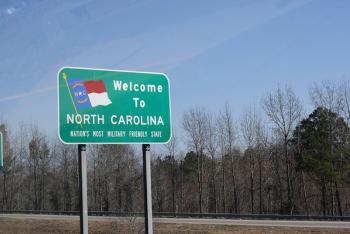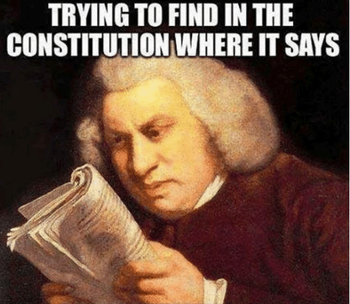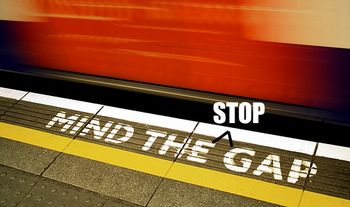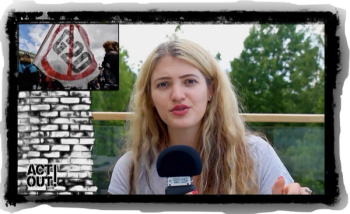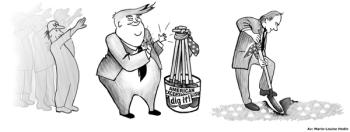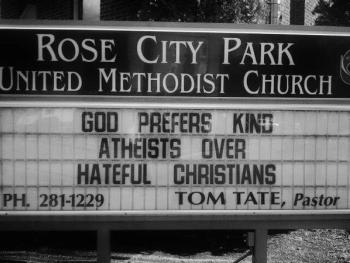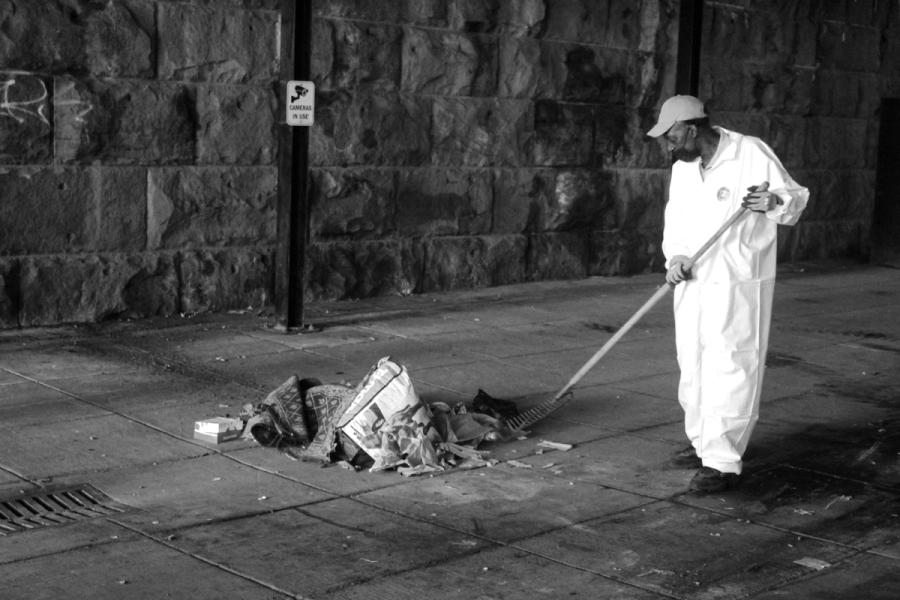
Microcosms of Mayhem & Humanity: Destroying Black & Brown Lives for High-Rises in the Nation’s Capital
2021-10-21
by Eleanor Goldfield
This article originally appeared on Mint Press News. Please check out their site for more radical and independent journalism!
“Where that McDonald’s is right now,” he says pointing across the street. “That used to be a news stand where I’d buy comics as a kid.” Dumah Muhammad stands in Adams Morgan Plaza in Washington, D.C., a light drizzle misting a small crowd of supporters and press. A few people wrangle a tarp over the PA system and there’s a tent where folks can grab snacks, pamphlets, water and shelter. Five Metropolitan Police cars are parked alongside the plaza and just behind the plaza there’s a staging area stacked with fencing and mingling cops.
Despite literally being surrounded, the energy in the plaza is that familiar direct-action blend of defiance and celebration. Between speeches, music pumps out of the PA and folks dance alongside anti-gentrification artwork and handmade signs. A luxury condo looms up the street like a sterile square omen. There’ll be a similar behemoth where we’re all standing (and dancing) if Truist Bank gets its way: a seven-story luxury condo right here in the middle of what’s locally known as AdMo Plaza, a space won through grassroots organizing now hoping to be saved by the same.
Truist Bank is a banking conglomerate made up of several banks including BB&T and SunTrust, themselves products of bloated mergers and acquisitions that go back to the Savings and Loan debacle. Before it was devoured by this insatiable stream of mergers, Perpetual Federal Bank owned the lot that is now the plaza, having bought it in 1976 after the community won a fight to keep the empty lot from becoming a BP gas station. What followed marked an incredible shift in banking policy. As the AdMo Plaza site tells it:
Perpetual Federal agreed in the chartering of the Adams Morgan branch by the Home Loan Bank Board to redress its history of redlining and discriminatory lending, to provide specific changes to its banking practices, and to create a sizable community space for public use, covered in a ‘good neighbor’ agreement between the Adams Morgan Organization and the bank.
Truist’s lawyers and hardhats keep trying
Truist has no interest in upholding its small predecessor’s agreement, which might not be surprising when you consider the fact that in just the last 10 years they’ve “paid $1,300,000,000 to settle three Federal cases for fraud, abuse, and racist discriminatory banking practices against Black and Latino customers.” Now Truist claims there’s nothing legally binding in the deed to keep the plaza as is. Plaza protectors counter by pointing out that public-use spaces are rarely deeded as such. Vikram Surya Chiruvolu, co-facilitator with Adams Morgan for Reasonable Development, points to Columbia Rd. NW, one of the plaza’s cross-streets, as an example. “It was once the boundary line of a number of plantation properties, and the road was created through public use to access those properties,” he explains. “It was never deeded specifically to the city nor recorded on the deeds of those properties.”
The battle between Truist and community members has slogged on now for five years, and Chiruvolu gives me the Cliff Notes of this judicial morass, saying that the goal now is to keep Truist from taking over the plaza while legal proceedings are ongoing. Despite the ongoing litigation, Truist has already tried twice to fence off the plaza, on September 22 and 24. On the 22nd, they were shut down by the D.C. Department of Consumer and Regulatory Affairs (DCRA) for not having the appropriate permit. On the 24th, they returned with the same permit and attempted to block off the plaza again, this time with heavy machinery. “They had four semis filled with concrete barriers blocking the road and idling – spewing exhaust all over the place,” Chiruvolu explains. Once again, however, they were shut down, but not before they had a chance to assault a few people — including Chiruvolu, who stood in front of one of the semis with his service dog Reggie. Plaza protectors are in a holding pattern now as Truist gets to work on securing the correct permits. In the meantime, plaza protectors continue to get the word out and advocate for those living in the plaza.

DC: a national champ in gentrification
The fight for AdMo plaza and those who live there is a connective thread in the history of grassroots organizing in what was once known as Chocolate City, where Black and Brown organizers resolutely asserted that Black lives are worth more than white property long before there were hashtags. And it’s this history of anti-racist and anti-gentrification organizing that’s at risk of being bulldozed along with the public spaces still enjoyed by residents today – residents who are increasingly white and well off.
“You can’t have a community with one type of people,” Muhammad says. The loss of community history represents a loss of present community and an imminent threat to the future. The deep roots of place that support a diverse and strong community are severed. In their place an arid topsoil blisters, supporting only the flimsy and splintered monocultures of gentrification.

As defined by the National Community Reinvestment Coalition (NCRC), gentrification is “a policy-driven process that begins with targeting low-income, urban communities for discrimination and neglect and ends with ‘improvements’ that exacerbate vulnerabilities that culminate in displacement.” In other words, white property over Black and Brown lives. For more than a decade, D.C. led the nation in gentrification, and is one of seven cities that together account for nearly half of all gentrification in the nation. According to a 2019 study by the NCRC, D.C. “was the most gentrified city by percentage of eligible neighborhoods that experienced gentrification” between 2000 and 2013, displacing an estimated 20,000 Black residents in that time period.
Diversity, lol
Unlike the tactics of old — like redlining and racial restrictive covenants (stipulations on deeds that, for instance, barred the sale or rental of property to “non-whites and people of Jewish descent”) — gentrification is more subtle. For instance, in Adams Morgan, you’ll see banners around the neighborhood that brag about diversity; the AdMo Business Improvement District (BID) touts AdMo as being the most “vibrant and eclectic” neighborhood in D.C. while unironically posting a picture of all-white members on their “History of the BID” page. It would seem that the History of the BID doesn’t include the history of Chocolate City.
The AdMo BID is one of 11 BIDs across the city, private-public partnerships that amount to joint ventures between business and property owners to do a wide variety of things – from power washing sidewalks to light installations and, of course, oiling the gentrification slip-n-slide. As Shannon Clark, co-founder of the unhoused support and advocacy group Remora House, put it: “It’s basically private governance over space where public money is funneled.”
In Northeast D.C., the NoMa (North of Massachusetts Ave.) BID has adopted a similar spin, reusing the word “vibrant” and throwing in descriptors like “hip” and “smart center of the nation’s capital.” It’s unclear whether they mean people who live there are supposedly more intelligent, or it’s a tech reference, or I’m just not hip or smart enough to get it. I know I’m certainly not “hip” enough to get behind the recent eviction of unhoused encampments at the foot of entire city blocks’ worth of new luxury real estate developments. But that’s probably because I don’t find racist capitalism hip either.

If you peruse the list of “What’s Next” on the NoMa BID site, they outline pretty clearly what all that new construction is for: swanky hotels, hundreds of new apartments, dozens of new condos, and hundreds of thousands of square feet of office and retail space — listed as Class A, a marker for the highest-quality, newly constructed, top-of-the-line spaces, which, as noted by commercial real estate experts SquareFoot, “command top rental rates” and attract “large financial institutions, ad agencies, law firms, and tech giants.” In other words, it sure as shit isn’t for the poor. In fact, it’s so off limits to the poor that they can not even be allowed to gaze upon it. Instead, they must be moved.
Clearing the brush
On October 4, city officials callously and violently removed unhoused people and their belongings from two underpasses in the NoMa area: L & 2nd St NE and M & 2nd St. NE. The official story was that it was a matter of public health and safety. This seems like an odd pitch when the CDC’s guidelines on encampments state:
[A]llow people who are living unsheltered or in encampments to remain where they are. Clearing encampments can cause people to disperse throughout the community and break connections with service providers. This increases the potential for infectious disease spread.
According to D.C.’s Office of the Deputy Mayor for Health and Human Services (DMHHS), their reasons for health and safety clean-ups are about garbage piling up, extreme weather in which unhoused would be at risk of injury or death, lack of running water, etc. These are indeed health and safety risks — the health and safety risks that go along with being unhoused. They can only really be solved by removing the unhoused element from the equation. Still, DMHHS’s own documentation explains that they will often do trash pickups from various encampments around the city and that after a full clean up, unhoused folks can and often do return to that same area, thus addressing health and safety concerns while simultaneously mitigating the risks highlighted in the CDC’s most recent guidelines. But see, the idea of returning to the same space doesn’t work within the paradigm of gentrification. So these most recent evictions in NoMa are part of a new cruelty — a new Pilot program that seeks to make more areas of D.C. permanent tent-free zones; in other words, to further criminalize poverty.
And while the goal of essentially outlawing homelessness can never be humane, it doesn’t even make logical sense unless you’re also eradicating the conditions that result in homelessness. If not, you’re just outlawing the effect without outlawing the cause, criminalizing poverty in a system that demands poverty as a foundation from which to extract, and on which to build, wealth.

View from the front
By the time I get to NoMa around 9:30 a.m., caution tape has already been bandaged around each underpass. Advocates and volunteers hold space, helping folks move their belongings and speaking out against the city for its inhumane treatment of the predominantly Black unhoused residents.
Maurice Cook, part of D.C. Ward 6 Mutual Aid and the Executive Director / Lead Organizer of Serve Your City DC, holds a megaphone and points it at city workers waiting for the signal to move in. “It’s easy to put a ‘Black Lives Matter’ sign in your yard,” he says. “But what good is it if you’re not willing to stand up for Black folks?” He addresses the Black city workers assembled on the other side of the street: “You could slip into this situation at any time. This country does not love us. It hates us.” He motions to the long block of new luxury buildings and then looks back to both the city workers and the unhoused residents: “Look at all the work going into making sure we get nothing.”
In the simmering chaos, a man cries as workers in white coveralls walk around him to sweep up crushed belongings — poor people paid to destroy the lives of other poor people. Another man ducks under the caution tape in order to pick up his dog, placing it in a bike basket. A woman picks through a pile, as if she’s looking for something lost. A man hurries through his tent as the lights from a front-end loader blaze across his face. Community members step in to ask the heavy-machinery operator to start somewhere else. And in case you’re wondering, a front-end loader is basically like a bulldozer but with wheels rather than tracks like a tank. It’s mainly used to pick things up, and in this case deposit them in a waiting garbage truck.
That being said, it’s very capable of doing the damage of a bulldozer — be it to tents or indeed to people. A man was transported to a hospital after a front-end loader rammed into his tent while he was still inside. In the ensuing madness, city officials including MPD and Deputy Mayor for Public Safety and Justice Christopher Geldart tried to block advocates from reaching the man to see if he was ok. One advocate suffered multiple bruises from being grabbed and manhandled as she tried to squeeze through and check on the man, who was clearly in shock as well as being physically injured.
A big man, a little cosplay
Geldart in particular piqued my curiosity, as his bulky frame strode through the underpass wearing a shirt that identified him as part of the Homeland Security and Emergency Management Agency (HSEMA). When I reached out to HSEMA to ask why Homeland Security needed to be involved in an encampment eviction, the HSEMA Office of Public Affairs told me that “no employees or representatives from D.C. HSEMA were present or otherwise involved” in the eviction. When I sent in a picture of Geldart, they replied: “That is not an HSEMA employee. The photo is Christopher Geldart. He is DC’s Deputy Mayor for Public Safety and Justice. He has access to our apparel and wears it sometimes.”
Wait, what?! He has access to our apparel and wears it sometimes?! Who else has these closeted privileges? Can anyone just show up to official proceedings, start throwing their weight around while playing a shady game of dress up? I followed up, asking whether it was common practice to let people who aren’t affiliated with the agency wear agency clothing while on duty in other capacities, but received no reply. It’s worth noting as well that Geldart did at one point work for HSEMA but resigned in 2017 “following a report from the Office of the Inspector General that substantiated two ethics allegations.”
Bowser’s performative wokeness
He was appointed Deputy Mayor for Public Safety and Justice this past January and pretty quickly embraced the irony of his title, dodging a question about racial justice (or lack thereof) in the district. This isn’t really that unusual for D.C. Mayor Muriel Bowser’s office though. In 2016, Bowser appointed Peter Newsham as Chief of Police – a man with a history of racism and brutal crackdowns against protestors, who in 2019 penned a letter claiming “Stop and Frisk is essential.” But hey, Bowser also had ‘Black Lives Matter’ painted onto 16th St. NW outside the White House so she gets full points for performative wokeness.

Also in the arena of performative wokeness is Bowser’s approach to ending homelessness. Back in 2015, Bowser announced “a plan to make homelessness, rare, brief and non-recurring by 2020.” Spoiler alert: it’s not rare, it’s not brief, and it is recurring. On October 1 of this year, her office released a statement outlining plans and monies for affordable housing and to once again “make homelessness, rare, brief and non-recurring” — but this time without a deadline. Just kicking the can down the street of luxury real estate developments. Interestingly enough, her office omitted any mention of violent encampment evictions as part of their strategy. There’s also no mention of how to actually facilitate outreach to unhoused folks, an issue that has already seen dozens of people fall through the gaping chasms in city policy.
Perpetual insecurity
I strike up a conversation with a man named Rick who tells me he used to live at the L & 2nd St. NE underpass in NoMa some eight years ago. Now his brother lives here. He would like to have his brother come stay with him but the affordable housing guidelines don’t allow it. So, he’s down there just to help his brother move and try to save some of his things.
Jeffrey Tsoi, from the Georgetown chapter of National Lawyers Guild, walks through the encampment with a colleague, talking to residents and taking pictures of their belongings. “The city is moving people out without a guarantee of housing,” he explains. “If property is thrown out, we’ll make a claim.” Some folks will head to another encampment and may have to redo this whole traumatic mess in a matter of weeks or months. One woman says she’s heard people talking about the city getting hotel rooms to house people temporarily but Rick shakes his head. “The city keeps saying that everyone’s taken care of but it’s not true,” he explains. “Sixty-six people need housing,” he says, moving his arm towards the underpass behind him and then down the block. “Only twelve people have gotten an apartment. And that’s temporary housing — it’s not even for good.” Shannon Clark echoes Rick’s sentiment. “There’s a perpetual feeling of insecurity,” she says. Of those who do get housing, they “know they might not have that voucher funded or renewed.” Amidst the confusion, one thing is clear: the city has done a terrible job on outreach and ensuring that those who need permanent housing have access to it.
Clark says that DMHHS’s approach has been one that betrays a foundational misunderstanding of the lived experience of being unhoused. Remora House does distribution to several encampments and Clark explains that “when we go out to them, we’re maybe seeing 20% of the people who live there. So if we know one person who isn’t on the list, there’s gotta be more.”
The list she’s referring to is the By-Name List (BNL), which is the city’s list of people currently in encampments who need housing. She says that if the city really wanted to compile a legitimate list like this, it would take a long time — not just a couple of weeks of people going out for a short walk-through of an encampment. People don’t just wait around for a city employee to come around and count them, and even if they did, that wait would be punctuated by disappointment. “DMHHS says they’re doing this work but they’re outsourcing it to NGOs and just posting up signs saying that people must have housing in two weeks,” Clark says. When she and other advocates confronted DMHHS in a recent digital meeting about the people who were falling through the cracks, the response was defensive, deflective and at times bizarre — with comments like this one from Deputy Mayor Wayne Turnage: “I don’t work for you, I’m a public servant.”
“They said ‘we will continue to do outreach in that area,’ but they’re not gonna be in that area anymore, you’re evicting them,” Clark says, sighing. “Then they said, ‘well, we do outreach all over the city.’ But that’s not how that works. People scatter and even advocates can’t find them again,” she says. This scattering of course represents another health and safety issue — the fact that the Pilot program aims to permanently clear several central D.C. encampments means that people will be farther away from help and services. It also poses a risk for those who end up in dangerous situations away from a place and people they’d gotten to know, a point to which I can personally relate, as someone who was unhoused in LA and skirted more than a few dangerous situations by having folks around me give me a lay of the land, and a rundown of everything from when cops roll by to which areas and people to avoid.
But very hypothetically, let’s say that DMHHS managed to properly count all the people who have now been scattered after the October 4 eviction, what’s the city-wide outreach plan look like now that the so-called eviction moratorium is ending? Back in July, D.C. Council voted to end the moratorium in stages — with Stage 2 hitting on October 12, when landlords can file for eviction for non-payment of rent. Considering the fact that D.C. has the third highest rental costs in the country — and that, already in October of last year, some 34,000 tenants were behind on rent — the outlook is grim.
Not rare, not brief, and very much recurring
Tenants who are behind on rent can apply to a program called Stay DC to cover what they owe but, as reported by one applicant, the application process is long and difficult, and the wait even more so. “My approval took 69 days, a very long time to wait for money intended to help neighbors who need emergency cash to keep roofs over their heads next month,” the author Gordon Chaffin writes. These hurdles come on top of pre-existing information gaps and barriers that I mentioned in a previous article on housing accessibility. In short, homelessness is about to be a lot less rare, brief and non-recurring. Even before the pandemic, homelessness was on the rise and unsheltered homelessness had risen particularly sharply — some 30% over the last five years.

These numbers might make it seem that eradicating homelessness is nearly impossible. It’s not a way to do it that’s lacking, however; it’s a will. Chiruvolu has been helping folks living in AdMo Plaza navigate bureaucratic abysses and get things like ID’s that will allow them to access housing and services, something at which the city has completely failed. “[D.C. Ward 1 Councilmember Brianne] Nadeau claims she’s been working very hard for the plaza folks,” he says. “But she basically just shifted case management to [local NGO] Miriam’s Kitchen. After six months of ‘work,’ she couldn’t seem to get the people in the plaza an ID,” he explains, shaking his head.
On October 5, a two-week stay at a local Motel 6 was up for residents of the plaza, and I met a few as they came back, more frustrated than ever. Incidentally, it wasn’t even the city that paid for their stay. Truist Bank paid Miriam’s Kitchen to house the plaza residents, clearly hoping that the plaza would be fenced off and ‘secured’ by the time the stay was up. As it stands, the plaza still stands, but it’s small consolation for those who aren’t sure where and how they’ll be living in the coming days and weeks.
“This is what they offer me”
“I’m caught between,” Larry Richardson says. A Vietnam veteran, Richardson grew up in Adams Morgan and Southeast D.C. and has lived in AdMo Plaza for two and a half years. “I want an apartment. I don’t wanna live like this. I’m 74 years old.” Chiruvolu and other advocates are currently working to untangle an identity mess that Richardson finds himself in with the VA, who has confused him with a deceased Larry Richardson and therefore claims he isn’t eligible for benefits.
“The things that I’ve been through for this country,” he says, bowing his head. “And this is what they offer me. And I’ve tried to pick myself up — it’s hard. The government makes it hard. The city hasn’t helped at all,” he explains. “I tried staying in a shelter but I couldn’t deal with it — the bugs, the whole thing. Inhumane. And I’m human, I can only take so much. I got feelings, just like everyone else.” His story isn’t uncommon. Many people avoid shelters for any number of reasons — from unsanitary conditions, to accessibility, to violence, to being split up from partners.
Meanwhile, I call Muhsin Boe Luther Umar, Resident Council President at Garfield Terrace and D.C. Advisory Neighborhood Commission (ANC) 1B03 Member, to ask if he has any suggestions on how to get Richardson housed. Garfield Terrace is a senior living building in D.C.’s Ward 1. Umar sighs and says, “We’ve got 220 units at GT, and only 120 apartments filled. I’d love to get him here but the only way I know to do it is their way.” Much like Rick, who can’t have his brother come stay with him, housing advocates and even ANC members can’t fill empty apartments with people who need them.
“A political and economic racket”
Chiruvolu says he’s run into similar hurdles with regards to saving the plaza. “There have been five ANC resolutions against re-privatizing the plaza — including one that suggests turning the building into a public library while keeping the plaza as is,” he explains. “ANC resolutions aren’t law but they’re supposed to hold a lot of weight before the mayor. Clearly, that’s not the case here. It’s a political and economic racket.”
Instead of addressing these completely illogical and corrupt webs of gentrified inhumanity, politicians and city employees put their full attention and literal weight behind tangling them further. They partner with big businesses and real estate developers rather than community members and organizers. They lean into gentrification rather than revitalization, evicting people rather than making sure they can stay in their homes or find a home. Meanwhile, the big banks and business development organizations hide behind vibrant and eclectic PR campaigns as they whitewash history, gut communities, and exile the diversity they so boldly claim to uphold.

“People used to care,” Richardson says, looking down and shaking his head. “People used to say ‘good morning.’ There used to be unity, forgiveness and heart.” Richardson and I sit in AdMo Plaza in a couple of chairs overlooking the old redline crossroads of 18th St. NW & Columbia Rd. NW. “I’m living in a time period I don’t recognize. We’re all living on this earth, we should work together,” he says. “I grew up in a good family where we helped each other. This is not my way. The way I came into this world — that’s how I wanna go out.”
One street corner and sea to shining sea
This is a D.C. story — but it is also a microcosm of mayhem. It may seem small to focus energy or even a whole article on a single plaza, a couple of underpasses — but these are the literal frames of our daily lives, the spaces in which we exist, the ground where we may sink or thrive. What radical histories are being bulldozed in your town, your city? How many of your neighbors are caught in the jaws of gentrification, literally and figuratively shoved aside in the quest for more profit, more property? What spaces are being overtaken by this creeping death?
It’s a stark and gloomy consideration, but alongside these microcosms of mayhem are the microcosms of humanity: the people who refuse to accept that white property matters more than Black and Brown lives, the people who refuse to accept hundreds of empty homes when hundreds are unhoused. The battle against gentrification is just as national as it is local. The battle waged on one street corner echoes across redlined borders from coast to coast. These are our local frontlines and in naming them, in uplifting them and the communities and history they hold, we build not only resistance but active solidarity. We uncover buried and bulldozed histories — we sow seeds of community in that arid topsoil.
“You gotta believe in something,” Richardson says as the sun dips down behind the plaza. “I choose to believe in goodness. I refuse to surrender. I can’t give up.”

